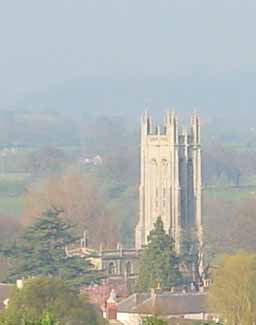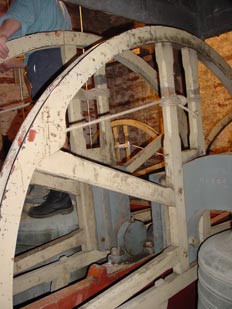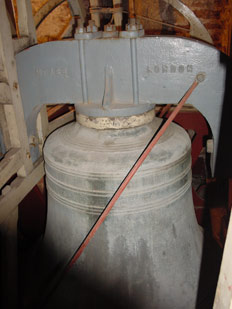At the 1628 casting, the churchwardens and any inhabitants were allowed to watch the proceedings, provided that they behaved themselves. Bell casting was quite a sight, and a major technical feat. First the bell mould had to be made, a long slow process that took months, as each stage of making the inner core and outer mould, using clay bound with hair, had to be thoroughly dried out. Moisture in the mould could make it explode when the molten bronze was added. The mould was made in a pit in the ground, which was then filled up so that when the bronze was added, it did not push the outer wall of the mould out of shape. The top of the mould was at ground level.
Next to the mould was a big clay and stone furnace, fired by charcoal and big bellows that took many man hours blowing in air to reach the required temperature. The furnace narrowed at the top with a hole to allow exit for the fire gases. These went green when the copper melted. At this point, if a new bronze mix was being made, tin would be added to the copper in the crucibles inside the furnace.
The crucibles would be stirred with green oak poles to de-oxidise the mix. When all was ready, the fiercely hot wall of the furnace was broken open to allow access to the brightly glowing crucibles, that were then lifted out with seven feet long iron carrying poles. For the Wrington Tenor, two tons, over 14 gallons (235 litres) of molten bronze had to be produced. This was then carried over to the top of the mould and poured in until the molten bronze ran out of the top; the bronze being then left to set. The bell had then to be dug out and lifted from the pit.
2. The 1700’s
Later on, in 1702 – 3, the Tenor was taken to Gloucester and recast by Abram Rudhall, to a weight of 38 cwt. (1.9 tonnes).The bell was too big for the Bristol bell foundry to manage. The old bell was carried in a strengthened cart, probably pulled by plough horses with other spare horses accompanying it. This indicates improved road conditions as it was now not necessary to cast a heavy bell in a bell pit in the village. The team of men set out for Gloucester in the Autumn of 1702, carrying their near 2 tonnes of bell.
The labour involved in carting a heavy bell as far as Gloucester, and also the collection of a new clapper that had been forged in Bristol was reflected in the bill for beer amounting to £6 17/7d. Adjusted by the Retail Price Index, between 1702 and the present, £6 17/7d was a beer bill worth £1,004 in today’s money. Beer at that time was a grassroots way of paying by barter – beer being a method of “banking” or storing food raised in the summer. Some of the beer would have been carried in barrels on the cart, to be used to pay for accommodation, food and drink and for fodder for the horses. Travel time would have been in the region of one week each way.
In the mid 1700’s a number of the lighter bells were melted down and new bells made, increasing the number to six, the third heaviest ring of six bells in the country. All casting was done at the neighbouring village of Chew Stoke, where the Bilbie family had a bell foundry. Again, the preferred method of travel was carts pulled by plough horses, with carrying payment/expenses covered through the medium of beer.
3. 1800’s and 1900’s
The Tenor did not need to be recast again until 1845. The Tenor and Treble bells were sent from Yatton railway station to the Whitechapel bell foundry in London. The age of the small local bell foundry had come to an end with the coming of the railways. The bells went via Yatton station.
When the new bells had returned and finally been hung, it is recorded that the last member of the Bilbie family, a small man, old and bent with hair over his collar, came from Chew Stoke to hear whether the new bells were the equal of the old Bilbie bells. His assessment was not recorded. Mears of Whitechapel recast the Treble and the Tenor at a cost of £134 3/0d. , £10,652 in current money – all costs paid for in cash.
Just because they were now sent to London did not guarantee quality. When the Tenor returned to Yatton station the Wrington steeple keeper examined the bell, and insisted that the Tenor should not to be removed from the station as it was unsatisfactory. An accident must have taken place with the mould: it had separated in three places causing an unsightly appearance. The “canon” at the top of the bell, appeared to be of very inferior metal, very drossy and apparently unsound, making it likely that the canons would soon crack under use and the bell need to be recast. A letter was sent to Whitechapel. Mears answered the complaint by saying that they would recast the bell if it was found to be defective. The bell was returned and recast again.
In 1911 all six bells were sent to Whitechapel to be retuned and four additional lighter bells were cast, making the present ten. These were also sent by rail via Yatton station. This was largely at the initiative of Mr John Harley Bridges Hesse that the old six bells were increased to the present ring of ten. The old bells were not recast but were taken away (via Yatton Station) to Mears, Whitechapel and retuned. Mears installed a new frame with steel framework and cast iron cages. The bells were hung in two tiers, the new top tier being level with the base of the previous frame.
Inscriptions on the four new bells refer to people prominent in the village at the date:
Treble: Mr. H.H. Wills 1911. Mr. Henry Herbert Wills was a great benefactor to the villages of Redhill and Wrington. To him Wrington owes the gift of a cottage and site for the Memorial Hall, as well as a gift of £1000 towards the cost of the building. Mr. Wills died in 1922 before the building of the hall began but his widow - Mrs. Mary Monica Cunliffe Wills whose name appears upon the second bell, laid the foundation stone in 1923 and opened the hall in 1924.
The initials on the third bell GMA and EMA refer to the Revd. G.M. and Mrs. Ashdown. He was Rector of Wrington from 1890 until 1924.
The fourth bell is inscribed `In Memoriam T.B. Harrison'. Major General Harrison lived at West Hay from 1887, was a J.P. for Somerset, a member of the Managers of the School and was the first Chairman of the Parish Council. He had the John Locke Hall built and after his death in 1903 his daughters handed over the hall to the Parish together with an endowment of £1000.
1985 brings us to the most recent recasting. When the 6th bell developed a crack it needed recasting. The bell was transported to Whitechapel by flatbed truck on the M5.






